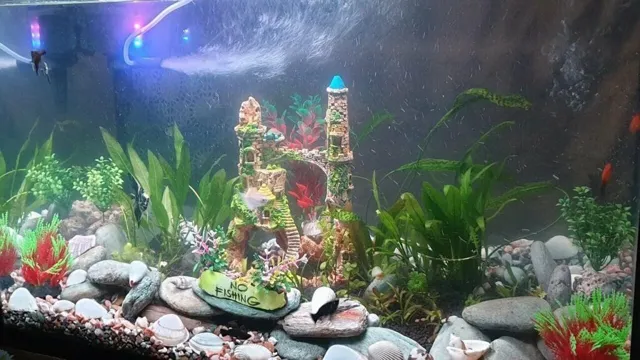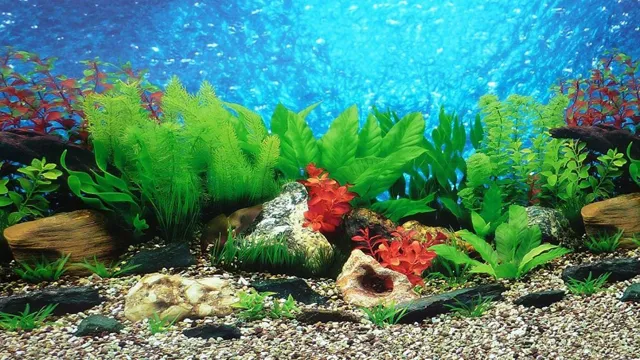How to Prep Leaves to Add to Aquarium for a Healthy and Natural Environment

Welcome, aquarium enthusiasts! Are you looking to add a touch of authenticity to your tank and create a natural habitat for your aquatic pets? If so, incorporating leaves into your aquarium may be just what you need. Not only do leaves provide a natural aesthetic, but they also have numerous benefits for your aquatic environment. In this beginner’s guide, we’ll discuss how to prepare leaves for your aquarium, which species work best, and how to manage them.
So, grab a cuppa and let’s dive in!
Why Add Leaves to Aquariums?
If you’re an aquarium enthusiast, you’ve probably heard about adding leaves to your tanks. Not only do they add an aesthetic appeal, but they also provide various benefits to the aquarium’s ecosystem. Adding leaves can help mimic the environment of a natural habitat for your fish, as they serve as hiding spots and breeding grounds for them.
Moreover, leaves also release tannins that help create a natural depth to the water color and aid in lowering pH levels. Before adding leaves to your aquarium, you need to prep them properly to ensure they do not add harmful chemicals to the water. You can soak them in water for a few days, boiling them or even rinsing them with clean water and baking them in an oven.
Overall, adding leaves can benefit your aquarium in many ways, so consider incorporating them into your tank!
Benefits of Leaf-Litter
Leaf-litter, aquariums Are you looking to enhance the natural beauty of your aquarium while also providing a healthy environment for your aquatic pets? Adding leaf-litter to your aquarium can offer many benefits. First and foremost, leaf-litter mimics the natural habitat of fish and other aquatic creatures by providing a layer of organic material at the bottom of the tank. This material creates a diverse and healthy ecosystem for the aquarium inhabitants by promoting the growth of beneficial bacteria and microorganisms.
These natural processes help to break down waste and toxins, maintaining a cleaner tank for longer periods of time. Additionally, the tannins released from the decaying leaves can provide a natural acidic buffer, which can help stabilize the pH level of the water. Adding leaf-litter to your aquarium not only enhances its aesthetic appeal but also helps to create a more balanced and healthy environment for your aquatic pets.

Choosing the Right Leaves
Adding leaves to aquariums is an excellent way to enhance the overall health of aquatic life. Not only do leaves provide a natural setting for creatures to hide and play in, but they can also help to create a more stable and balanced environment for fish and plants. However, not all leaves are created equal when it comes to aquascaping.
It is crucial to select the right type of leaves to ensure they do not rot and cause unwanted bacteria growth. Indian almond leaves, banana leaves, and oak leaves are all great options for aquariums. Indian almond leaves have strong anti-bacterial and anti-fungal properties, while banana leaves provide essential nutrients for fish and plants.
Oak leaves are rich in tannins, which can help to lower the pH level of water and regulate the growth of beneficial bacteria. By carefully choosing the right leaves and incorporating them into your aquarium set-up, you can create a beautiful, thriving ecosystem for your aquatic pets.
How to Clean and Prepare Leaves for Aquariums
If you’re thinking of adding leaves to your aquarium, it’s essential to clean and prepare them appropriately. Leaves, whether from hardwood trees or aquatic plants, contain natural compounds that can affect the water chemistry of your tank. So, before you toss them in, rinse the leaves under running water to remove any dirt, debris, or bugs.
Then, soak them in a separate container filled with water for a few days to allow the tannins to seep out. Tannins are organic compounds that give the water a mild tea-stained color, which many fish and invertebrates love. However, too many tannins can lower the pH of your water, which could stress your animals and affect the beneficial bacteria in your filter. (See Also: How to Clean Little Stones in Aquarium for Crystal Clear Water: A Step-by-Step Guide)
So, if you’re adding leaves to a new tank, go slow and test the water chemistry frequently until you find the right balance. With a little care, adding leaves to your aquarium can provide a natural and enriching habitat for your aquatic pets.
Step 1: Gather Fresh Leaves
When it comes to preparing leaves for your aquarium, the first step is to gather fresh leaves. Make sure to choose a variety of leaves that are safe for your fish. It’s best to pick leaves from non-toxic trees and plants that have not been sprayed with any pesticides or chemicals.
When selecting leaves, larger ones are best as they won’t decompose as quickly and will provide more hiding places for your fish. Once you have gathered your leaves, it’s important to clean them thoroughly before adding them to your tank. This can be done by rinsing them under cold water and gently scrubbing them with a soft-bristled brush to remove any dirt or debris.
By taking the time to properly clean and prepare your leaves, you’ll ensure a healthy and thriving aquarium for your fish.
Step 2: Rinse Leaves Thoroughly
When it comes to using leaves in aquariums, it’s important to ensure they are clean before adding them to the tank. The second step in preparing leaves for aquarium use is to rinse them thoroughly. This step will remove any dirt and debris that may be on the surface of the leaves.
It’s important to be gentle when rinsing the leaves to avoid damaging them. Use cool, clean water and rinse the leaves until the water runs clear. Once the leaves are clean, they are ready to be used in the aquarium.
Adding leaves to your aquarium can provide many benefits, such as improving water quality, providing natural hiding places for fish, and adding a natural aesthetic to the tank. By taking the time to properly prepare the leaves, you can ensure that they are a safe and effective addition to your aquarium.
Step 3: Boil Leaves to Sterilize
When it comes to preparing leaves for your aquarium, boiling is an essential step in sterilization. Boiling the leaves ensures that any harmful bacteria or parasites are eliminated, making them safe to add to your tank. To begin the process, gather the leaves you intend to use and rinse them thoroughly to remove any dirt or debris.
Next, place the leaves in a pot of boiling water, covering them completely. Allow them to simmer for at least 10 minutes, or until they start to soften. Once the boiling process is complete, remove the leaves from the water and allow them to cool before adding them to your aquarium.
Boiling is an effective method to prevent potential health risks to your aquatic pets and keep your tank clean and healthy. (See Also: How to Get Rid of These Small Worms in Aquarium: A Complete Guide)
Adding Leaves to Your Aquarium
Adding leaves to your aquarium can be a wonderful addition to your underwater world, but it’s important to prepare them properly before placing them in your tank. First, it’s crucial to select leaves that are pesticide-free and haven’t been exposed to pollutants or chemicals. Once you’ve found suitable leaves, give them a thorough rinse in clean water to remove any dirt or debris.
Next, boil the leaves for around 10-15 minutes to sterilize them and to soften them up, which will make them easier for your fish to consume. After boiling, you can either place them directly in your aquarium or leave them to soak in a separate container of water for a few days to leach out any tannins, which can change the pH of your tank. Adding leaves can provide a natural look to your aquarium and can also help your fish feel more comfortable by mimicking their natural habitat.
By following these simple steps, you can ensure that the leaves are safe for your fish and will enhance the beauty of your aquatic environment.
Step 1: Place the Leaves into Your Aquarium
If you’re interested in adding leaves to your aquarium, the first step is to carefully place them into the tank. But what kind of leaves should you use? Many aquarium owners swear by Indian almond leaves, which can help to create a natural environment for your fish and even help to improve their immune system. Other popular options include oak, beech, and maple leaves, as well as the leaves of certain aquatic plants.
Before adding any leaves to your tank, be sure to rinse them thoroughly to remove any dirt or debris, and consider boiling them to sterilize them. Once they’re ready, simply place them into your aquarium, positioning them where you and your fish can enjoy their natural beauty. Over time, the leaves will break down and help to create a natural cycle of nutrition for your aquatic pets.
So give it a try and see what kind of benefits you and your fish can enjoy!
Step 2: Observe the Leaves and Adjust Accordingly
When it comes to adding leaves to your aquarium, it’s important to observe their impact on the water and adjust accordingly. While many aquatic creatures benefit from the natural tannins and other compounds released by leaves, adding too many can create a murky and unbalanced environment. The key is to start slowly, adding just a few leaves at a time and monitoring water quality and clarity.
If the water becomes too turbid, it may be necessary to remove some of the leaves or replace them with a different type. On the other hand, if the water is clear but lacks the desired benefits, adding more leaves may be beneficial. The key is to find a balance that promotes a healthy and vibrant aquarium environment for your aquatic pets to thrive in.
So, if you’re considering adding leaves to your aquarium, start small and observe the impact before making any major changes.
Conclusion
In conclusion, adding leaves to your aquarium can provide a variety of benefits for your aquatic friends. To prepare your leaves, simply follow these steps: gather, clean, sterilize, and soak. With these easy steps, your leaves will be primed and ready to provide shelter, food, and even natural disinfectants for your beloved fish.
Prepping leaves for your aquarium is like prepping a meal for a dinner party – it takes a little effort, but the end result is worth it. So go ahead and leaf your worries behind and add some natural goodness to your aquatic world!” (See Also: How to Change Biorb Cube Aquarium Filter Easily in Just a Few Simple Steps)
FAQs
Why Should I Prep Leaves Before Adding Them to My Aquarium?
Prepping leaves helps to remove any unwanted bacteria or contaminants that may harm your aquarium’s ecosystem. It also helps to soften the leaves and make them more suitable for fish consumption.
What Are Some Methods for Prepping Leaves for My Aquarium?
Some methods for prepping leaves include boiling, soaking, and rinsing. Boiling and soaking can help remove any contaminants or unwanted bacteria, while rinsing helps to soften the leaves.
How Long Should I Boil Leaves Before Adding Them to My Aquarium?
You should boil leaves for at least 5-10 minutes to ensure any unwanted bacteria or contaminants are removed.
Can I Use Any Type of Leaves in My Aquarium?
You should only use leaves that are safe and non-toxic for your fish. Some good options include oak leaves, almond leaves, and Indian almond leaves.
How Many Leaves Should I Add to My Aquarium?
The number of leaves you add to your aquarium varies depending on the size of your tank and the type of leaves you are using. As a general rule, start with a few and gradually increase or decrease based on the needs of your fish.
Should I Remove the Leaves After They’ve Been in My Aquarium for a While?
Leaves can be removed and replaced as needed, as they will eventually break down and decompose. However, if you prefer to leave them in the aquarium, they can provide a natural food source for your fish.
What Are the Benefits of Adding Leaves to My Aquarium?
Adding leaves can provide several benefits, including natural food for your fish, a natural look and feel to your aquarium, and beneficial tannins that can help reduce stress in your fish.






